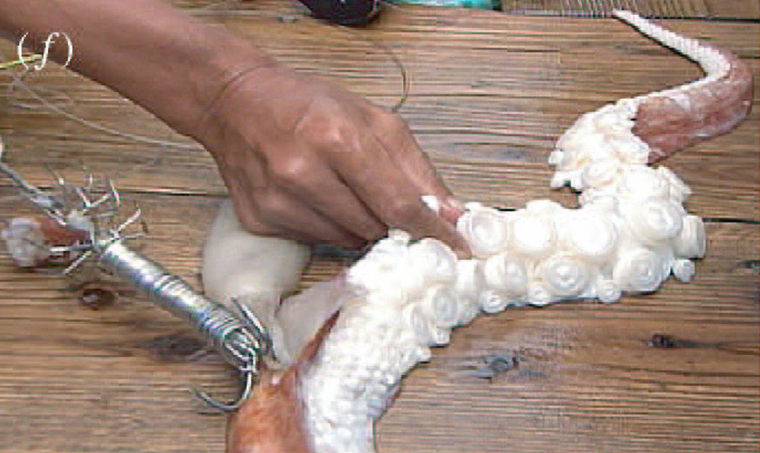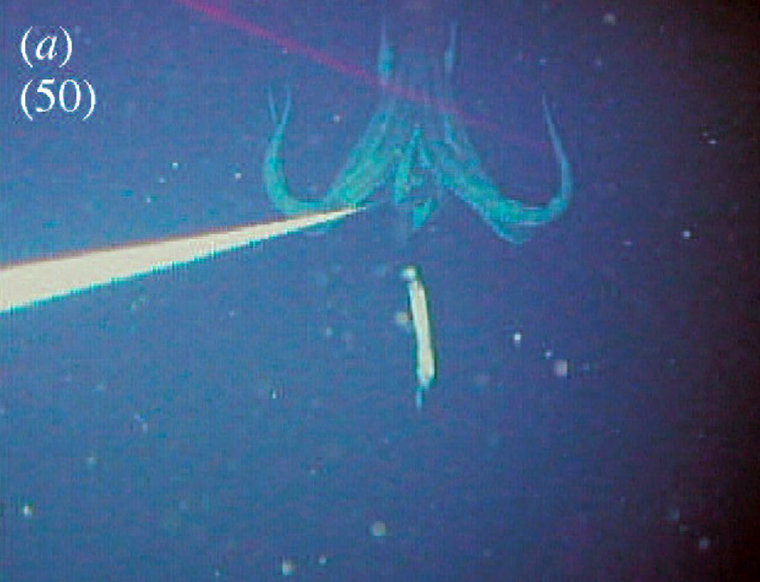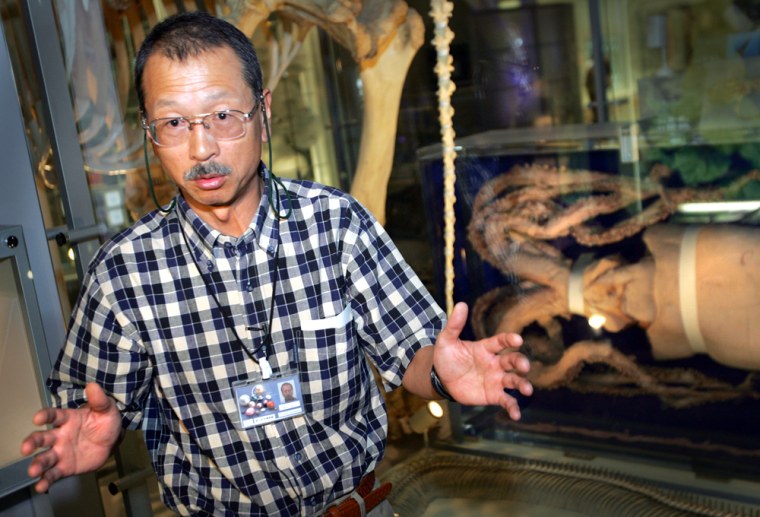When a nearly 20-foot long tentacle was hauled aboard his research ship, Tsunemi Kubodera knew he had something big. Then it began sucking on his hands. But what came next excited him most — hundreds of photos of a purplish-red sea monster doing battle 3,000 feet deep.
It was a rare giant squid, a creature that until then had eluded observation in the wild.
Kubodera’s team captured photos of the 26-foot-long beast attacking its bait, then struggling for more than four hours to get free. The squid pulled so hard on the line baited with shrimp that it severed one of its own tentacles.
“It was quite an experience to feel the still-functioning tentacle on my hand,” Kubodera, a researcher with Japan’s National Science Museum, told The Associated Press. “But the photos were even better.”
For centuries giant squids, formally called Architeuthis, have been the stuff of legends, appearing in the myths of ancient Greece or attacking a submarine in Jules Verne’s “20,000 Leagues Under the Sea.” But they had never been seen in their natural habitat, only caught in fishing nets or washed ashore dead or dying.
The Japanese team, capping a three-year effort, filmed the creature in September of last year, finding what one researcher called “the holy grail” of deep-sea animals.
The results were not announced until this week, when they were published in Wednesday’s issue of the British journal, the Proceedings of the Royal Society B: Biological Sciences. Kyoichi Mori, of the Ogasawara Whale Watching Association, co-authored the study.
Giant squid are the world’s largest invertebrates, having been known to exceed 50 feet.

Kubodera said the one he caught on camera was probably an adult female. He said the squid’s tentacle would not grow back, but its life was not in danger.
The photos earned the team cheers from researchers around the world, largely because of the difficulty of finding the mysterious giant.
“That’s getting footage of a real sea monster,” said Randy Kochevar, a deep-sea biologist with the Monterey Bay Aquarium in California. “Nobody has been able to observe a large giant squid where it lives. There are people who said it would never be done. It’s really an incredible accomplishment.”
Back in 2001, a different team of researchers captured video imagery of deep-sea squids in four different oceans, but those creatures were not thought to be of the giant Architeuthis variety. Instead, the researchers concluded that they belonged to a different group of squid species known as magnapinnids.
Whales help out researchers
The new photos — taken with strobe lights at 30-second intervals — also shed some new light on the animal’s behavior.
“We think it is a much more active predator than was previously thought,” Kubodera said Wednesday.
“It had previously been seen as more lethargic, and not as strong.”
In the pictures, the squid’s tentacles can be seen stretching out toward the bait, grasping it and pulling away in a ball.

It is then seen struggling to get itself free of the jig attached to the line under the remote-controlled camera. The struggle took place at a depth of between 2,000-3,000 feet.
Kudodera said catching the squid on film was the result of 10 years of sleuthing.
He added that he had some help — from a population of sperm whales.
“We knew that they fed on the squid, and we knew when and how deep they dived,” he said. “So we used them to lead us to the squid.”
Kudodera and his team found the squid about 10 miles off the remote island of Chichijima, which is about 600 miles southeast of Tokyo. They had been conducting expeditions in the area for about three years before they actually succeeded in making their first contact at 9:15 a.m. on Sept. 20 last year.

“We were very lucky,” he said. “A lot of research went into it, but still, others have tried and not succeeded.”
New Zealand’s leading authority on the giant squid, marine biologist Steve O’Shea, praised the Japanese team’s feat.
“Through sheer ... determination the guy has gone on and done it,” said O’Shea, chief marine scientist at the Auckland University of Technology, who is not linked to the Japanese research.
O’Shea said he hopes to capture juvenile giant squid and grow them in captivity. He captured 17 of them five years ago but they died.